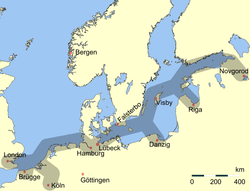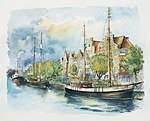Deventer
Deventer (Dutch pronunciation: [ˈdeːvəntər] (![]()
Deventer | |
|---|---|
City and municipality | |
Deventer skyline with the St. Lebuinus Church shown in the centre | |
 Flag  Coat of arms | |
.svg.png) Location in Overijssel | |
| Coordinates: 52°15′N 6°9′E | |
| Country | Netherlands |
| Province | |
| Government | |
| • Body | Municipal council |
| • Mayor | Ron König (D66) |
| Area | |
| • Total | 134.33 km2 (51.87 sq mi) |
| • Land | 131.23 km2 (50.67 sq mi) |
| • Water | 3.10 km2 (1.20 sq mi) |
| Elevation | 9 m (30 ft) |
| Population (January 2019)[3] | |
| • Total | 99,957 |
| • Density | 762/km2 (1,970/sq mi) |
| Demonym(s) | Deventers |
| Time zone | UTC+1 (CET) |
| • Summer (DST) | UTC+2 (CEST) |
| Postcode | 7400–7438 |
| Area code | 0570 |
| Website | www |
History
Foundation and development in the Middle Ages
Deventer was probably founded around AD 768 by the English missionary Lebuinus, who built a wooden church on the east bank of the river IJssel. In January 772 the sack and burning of this church by a Saxon expedition was the cause for the first punitive war waged by Charlemagne to the Saxons, in which, in retribution, the Irminsul (the Saxon sacred tree, probably near modern Paderborn) was destroyed. This was not the first human settlement at the location; between 1981 and 2006, remains of a Bronze Age settlement (dated to c.400 AD) were excavated at Colmschate, 4 km east of the current city
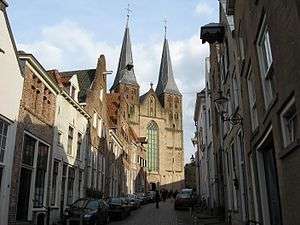
The village of Deventer, already important because of a trading road crossing the river IJssel, was looted and burnt down by the Vikings in 882. It was immediately rebuilt and fortified with an earthen wall (in the street Stenen Wal remains of this wall have been excavated and restored).
Deventer received city rights in 956, after which fortifications were built or replaced by stone walls around the city for defense. Between 1000 and 1500, Deventer grew to be a flourishing trade city because of its harbour on the river IJssel, which was capable of accommodating large ships. The city eventually joined the Hanseatic League.
One of the commodities it traded in, dried haddock and cod from Norway, gave the citizens the nickname they carry to this day: "Deventer Stokvis" In the 15th century, Deventer had a common mint, where coins for the three IJssel cities Deventer, Zwolle, and Kampen were made.
Deventer is the birthplace of Geert Groote and home to his Brethren of the Common Life, a school of religious thought that influenced Thomas a Kempis and Erasmus in later times. Together with Haarlem it was among the first cities to have printing presses, dating back to as early as 1477. From around 1300, it also housed a Latin School, which became internationally renowned, and remained in service in changing forms until 1971. Its most well-known was the scholar Desiderius Erasmus, who was born in 1466 and attended the school from 1475 to 1484.
16th–18th centuries

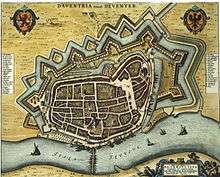
Between 1500 and 1800, the volume of water flowing through the IJssel decreased, decreasing the importance of Deventer's harbour. The competition with trade centres in Holland, as well as the religious war between 1568 and 1648, brought a decline in the city's economy.
In the 18th century, the iron industry came to Deventer. East of the town, so-called "oer", riversand containing iron, was found as early as 900. From this material, ore was produced and brought to town. The main road of the villages Okkenbroek, Lettele and Schalkhaar is still named Oerdijk (Ore Dyke).
Modern times
In the 19th century, Deventer became an industrial town. Bicycles (Burgers), carpets (Koninklijke Deventer Tapijtfabriek), tins and cans for food and drinks (Thomassen & Drijver), cigars (Horst & Maas en Bijdendijk & Ten Hove), foundry and heavy machinery (Nering Bögel), and textiles (Ankersmit)[4] were produced until the mid to late 20th century. Some of these industries are still thriving today, such as beds and accessories (Auping) and publishing (Wolters Kluwer, now headquartered in Alphen aan den Rijn)
The city's trade and industry is still of some importance. The city is host to a factory producing central heating systems, as well as Wolters Kluwer, a global information services and publishing company.
The Deventer honey cake (Bussink Deventer Koek), produced in Deventer for over 500 years, is still manufactured locally and sold all over the Netherlands and beyond.
World War II

Deventer has seen few military engagements throughout its long history, although it was a garrison city of the Dutch cavalry. The industrial area and harbour were bombed heavily during World War II. The city centre has been largely spared, thus offering a view that has remained largely unchanged for the past few centuries.
The female Jewish poet and writer Etty Hillesum lived in Deventer during the war before being deported to Auschwitz.
In Schalkhaar, a village only 2 km northeast of the city centre, barracks were used by the German occupying forces to train Nazi policemen. The compound is now a centre for asylum seekers.
Deventer has been somewhat popular with the film industry. During the production of the 1977 film A Bridge Too Far, all of the scenes taking place in nearby Arnhem were filmed in Deventer - as Arnhem itself had lost its historic centre.
Geography

Associated hamlets at second level
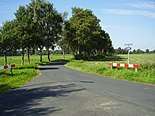

The population centres in the municipality are:
- Deventer (see below)
- Snippeling (a small community about 2 km east of the city centre)
- Colmschate (Deventer suburb quarters surrounding eponymous village 4 km east of the city centre, ice skating hall, small railway station)
- De Bannink
- Oxe
- Diepenveen, a village 4 km to the north, surrounded by forest
- Molenbelt
- Rande
- Tjoene
- Lettele, in a forest area
- Linde
- Oude Molen (old mill)
- Zandbelt
- Okkenbroek
- Schalkhaar (former centre of Diepenveen municipality including Lettele and Okkenbroek until 1999)
- Averlo
- Frieswijk
- Bathmen (independent municipality until 2005)
- Apenhuizen
- Dortherhoek
- Loo
- Pieriksmars
- Zuidloo
Culture
Sights
- The Waag (Weighing-house) on the edge of the Brink square, built in 1550 and restored in 2003. The Deventer City Museum is housed inside the Waag. The Museum's collections include industrial and trading history, paintings by Gerard Terborch and Han van Meegeren, silver objects, and prehistoric findings). Thea Beckman's novel Het wonder van Frieswijck ("The Frieswijck Miracle") features the Waag.
- On the outer wall of the Waag hangs a large kettle that is over 500 years old, said to have been used for a public execution in the late Middle Ages; a man who had produced counterfeit coins was cooked to death in it. According to local tradition, there are holes in the kettle shot by footmen of Napoleon's army around 1809.
- The Saint Lebuïnuskerk (St. Lebuin's Church) in Gothic style, with ceiling paintings and an organ. Its tower can be climbed in summer.
- The Brink (market square) with houses, shops, and cafes dating from 1575–1900. The market square is also the centre of Deventer nightlife. Alongside this square there is the Bussink "Koekhuisje", where you can buy Deventer Koek (honey-cake). Markets take place every Friday (including one on Good Friday, following a medieval tradition) and Saturday.
- The Speelgoedmuseum (Toy Museum) behind the Waag, housed in an old house in the city
- The medieval Bergkerk (Mountain Church), on top of a small hill (old river dune), now a museum for modern art.
- The old streets around the Bergkerk, known as Bergkwartier (Mountain Quarter) situated on and around an old river dune.
- The Stadsarchief en Athenaeumbibliotheek (City Archive and Athenaeum Library), the oldest scientific library of the Netherlands (founded in 1560).
- De Proosdij in the Sandrasteeg is the oldest stone house of the Netherlands still in use. The earliest parts dating back to around 1130.
Sports
Deventer is the home of professional Football club Go Ahead Eagles, who are housed in stadium De Adelaarshorst. De Adelaarshorst is situated in a 1930s neighbourhood and one of the oldest stadiums still in use today. The club was founded in 1902 as Be Quick, although the name was soon changed to Go Ahead at the request of the Dutch Football Association. The suffix Eagles was added in 1971, following a suggestion from the then coach, Barry Hughes. Go Ahead Eagles has been the club of Marc Overmars, Paul Bosvelt, and Bert van Marwijk, whilst providing Henk ten Cate and Leo Beenhakker with their first experience of management.
The 1992 founded skating rink De Scheg, which is semi-indoor since 2011, is in the top 10 of fastest skating tracks of the Netherlands. It has been the training accommodation of skaters including Olympic champion Mark Tuitert and the retired former world champion sprint Erben Wennemars.
Deventer also houses a number of watersports clubs, due to its situation on the banks of the river IJssel.
Events and festivals
- In the first weekend of July, the city centre is the scene of the open air festival "Deventer op stelten" (Deventer on Stilts). Actors and artists give free performances in the streets and on the Brink square. All actors must use stilts during their acts.
- In August, Deventer is home to Europe's largest book fair, attracting 125,000 visitors.[5]
- The Dickens Festival in December sees some of the oldest streets and alleys in the city dressed up in the style of the Victorian era. In 2018, the festival attracted 125,000 visitors.[6]
Government
Transport
Deventer has 2 railway stations - for destinations see
Notable residents
Public thinking & Public Service
.jpg)
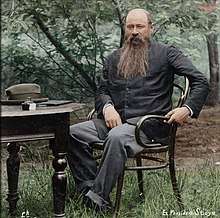
- Lebuinus (??-ca.775) the Apostle of the Frisians and patron of Deventer
- Saint Radboud (before 850 – 917) Bishop of Utrecht 899 to 917
- Geert Groote (1340–1384) a Dutch Roman Catholic deacon, founder of the Brethren of the Common Life [9]
- Gerlac Peterssen (ca.1377 – 1411) a Dutch mystic [10]
- Alexander Hegius von Heek (ca.1435–1498) a German humanist who settled in Deventer [11]
- Jacobus Revius (1586–1658) a Dutch poet, Calvinist theologian and church historian
- Samuel Holland (1728–1801) a Royal Engineer and Surveyor General of British North America
- Abraham Josias Sluysken (1736-1799) last Governor of the Dutch Cape Colony
- Rutger Jan Schimmelpenninck (1761–1825) a Dutch jurist, ambassador, politician and Grand Pensionary of the Batavian Republic
- Frans Adam van der Duyn van Maasdam (1771-1848) nobleman, officer and politician
- Louis Gerlach Pareau (1800–1866) a theologian and academic, co-founded Groningen theology
- Willem Jan Knoop (1811–1894) a Dutch lieutenant-general, military historian, and politician
- W. R. van Hoëvell (1812–1879) a minister in the Dutch East Indies, politician and reformer
- Elisabeth van Dedem Lecky (1842–1912) a Dutch-Irish writer, historian and suffragist
- Martinus Theunis Steyn (1857–1916) a South African lawyer, politician and statesman [12]
- Han Hollander (1886–1943) the first Dutch radio sports journalist
- Etty Hillesum (1914–1943) wrote about the persecutions of the Jews during the German occupation
- Bé Udink (1926–2016) a Dutch politician, government minister, diplomat and businessman
- Willem Scholten (1927–2005) a Dutch politician, government minister and economist
- Jomanda (born 1948) a controversial Dutch healing medium
- Guusje Ter Horst (born 1952) a retired Dutch politician and psychologist
The Arts
_Hiddes_Halbertsma.jpg)
- Jan Pieterszoon Sweelinck (1562–1621) a Dutch composer, organist and pedagogue
- Bartholomeus Breenbergh (1598–1657) a Dutch Golden Age painter of Italianate landscapes
- Gerard Ter Borch (1617–1681) a Dutch Golden Age genre painter
- Justus Hiddes Halbertsma (1789–1869) a Frisian writer, poet, minister and linguist
- Han van Meegeren (1889–1947) a Dutch painter, portraitist and art forger
- Truus Schröder-Schräder (1889–1985) a Dutch socialite, involved with avant-garde artists and architects of the De Stijl movement, lived in the Rietveld Schröder House
- Mannus Franken (1899–1953) a Dutch filmmaker, developed the Indonesian cinema[13]
- Jan Kleinbussink (born 1946) a classical musician, cantor-organist of the Lebuïnus Church
- Pieter Jan Brugge (born 1955) a Dutch film producer[14]
- Rob Voerman (born 1966) a Dutch graphic artist, sculptor and installation artist
Science & Business
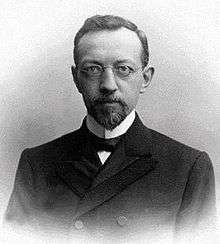
- Jacob van Deventer (ca. 1500 in Kampen – 1575) a Dutch cartographer of the Renaissance
- John Groenveldt M.D. (ca.1647-ca.1710) a physician, member of the Royal College of Physicians[15]
- Willem ten Rhijne (1647–1700) a doctor and botanist with the Dutch East India Company
- Johannes C. H. de Meijere (1866–1947) a Dutch zoologist and entomologist
- Lourens Baas Becking (1895–1963) a Dutch botanist and microbiologist
- David de Wied (1925–2004) a Dutch professor of pharmacology at the University of Utrecht
- Hubert Schoemaker (1950–2006) a Dutch biotechnologist
Sport
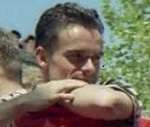
.jpg)
- Gerard le Heux (1885–1973) a horse rider, team bronze medallist at the 1928 Summer Olympics
- Jan Bultman (born 1942) a former water polo player, competed at the 1964 Summer Olympics
- Dick Schneider (born 1948) a retired Dutch footballer with over 500 club caps
- Bert van Marwijk (born 1952) a Dutch former footballer with 468 caps and current manager
- Jan van Dijk (born 1956) a footballer with 465 caps with FC Groningen and current manager
- René Temmink (born 1960) a Dutch former football referee
- Gertjan Verbeek (born 1962) a Dutch former footballer with 285 caps and current manager
- Ron Dekker (born 1966) a breaststroke swimmer, competed at the 1988 Summer Olympics
- Jan Michels (born 1970) a Dutch footballer with over 400 club caps
- Marc Overmars (born 1973) footballer with 399 club caps, director of football at AFC Ajax
- Victor Sikora (born 1978) a Dutch football player with 330 club caps
- Marloes Coenen (born 1981 in Olst) a retired Dutch mixed martial artist
- Boaz Meylink (born 1984) a Dutch rower, team bronze medallist at the 2016 Summer Olympics
- Bas Dost (born 1989) a Dutch professional footballer with over 300 club caps
- Carlijn Achtereekte (born 1990) a long distance speed skater, gold medallist at the 2018 Winter Olympics
- Elis Ligtlee (born 1994) a Dutch track cyclist, gold medallist at the 2016 Summer Olympics
Gallery
- Deventer, churchtower: the Saint Lebuinus Church
- Deventer, centre: de Brink
- Deventer, centre: de Brink
- Deventer, railway station
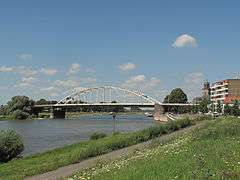 Deventer, bridge: de Wilhelminabrug
Deventer, bridge: de Wilhelminabrug.jpg) Deventer, Netherlands - panoramio
Deventer, Netherlands - panoramio Deventer, windmill: de Bolwerksmolen
Deventer, windmill: de Bolwerksmolen.jpg) De IJssel bij Deventer, Wellekade
De IJssel bij Deventer, Wellekade.jpg) Grote of Lebuinuskerk, Deventer
Grote of Lebuinuskerk, Deventer
References
- "Kerncijfers wijken en buurten" [Key figures for neighbourhoods]. CBS Statline (in Dutch). CBS. 2 July 2013. Retrieved 12 March 2014.
- "Postcodetool for 7411KT". Actueel Hoogtebestand Nederland (in Dutch). Het Waterschapshuis. Retrieved 27 March 2014.
- "Bevolkingsontwikkeling; regio per maand" [Population growth; regions per month]. CBS Statline (in Dutch). CBS. 1 January 2019. Retrieved 1 January 2019.
- https://www.youtube.com/watch?v=vZ9UNQK_Jqs
- "Algemene informatie". www.deventerboekenmarkt.nl. Retrieved 2019-03-09.
- "Dickens Festijn weer goed voor 125.000 bezoekers". www.destentor.nl. Retrieved 2019-03-09.
- "Twin Cities of Tartu". ©2007 City of Tartu. Retrieved 2009-01-04.
- "Working visit and celebration 25 years partnership Sibiu-Deventer". 2015. Retrieved 3 Jan 2020.
- . Encyclopædia Britannica. 12 (11th ed.). 1911.
- . Catholic Encyclopedia. 11. 1911.
- . Encyclopædia Britannica. 13 (11th ed.). 1911.
- . Encyclopædia Britannica. 25 (11th ed.). 1911.
- IMDb Database retrieved 23 February 2020
- IMDb Database retrieved 21 February 2020
- . Dictionary of National Biography. 23. 1890.
External links
| Wikimedia Commons has media related to Deventer. |
| Wikivoyage has a travel guide for Deventer. |
- . Encyclopædia Britannica. 08 (11th ed.). 1911.
- Official website
- Official Tourist website
